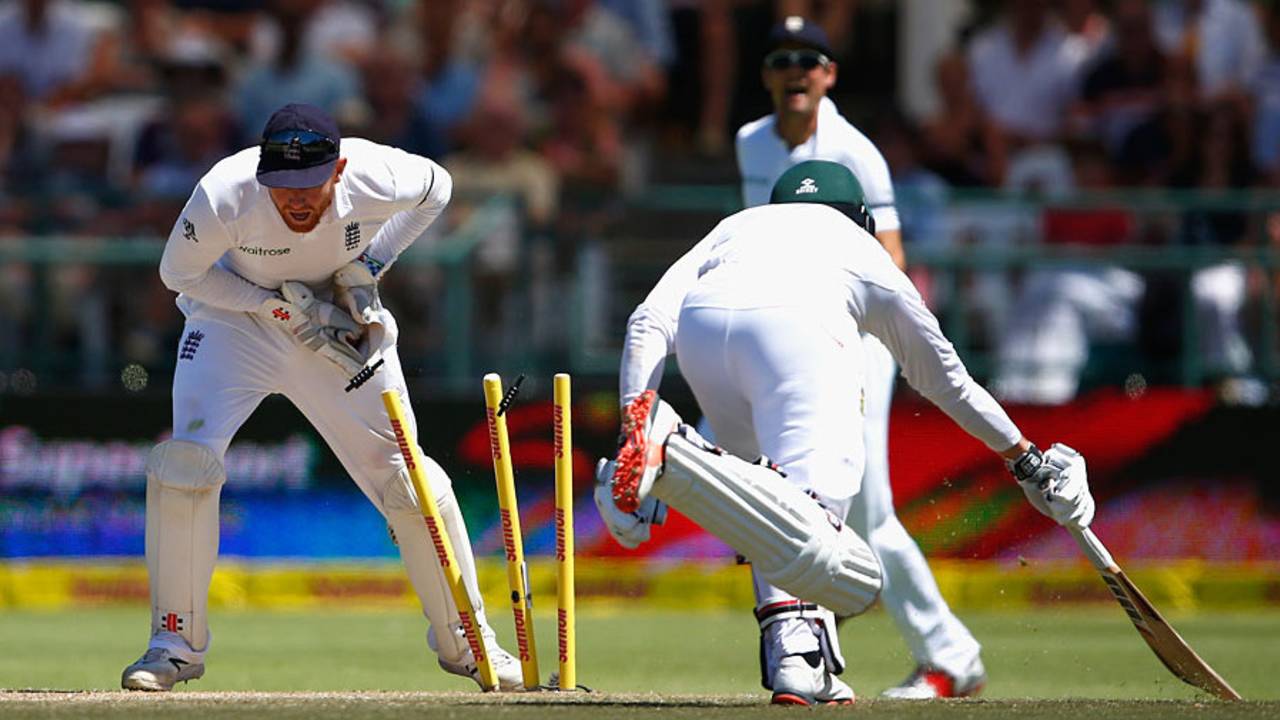South Africa, you have a problem. Not the half-problem you had in India or even in Durban where the batsmen went missing but at least the bowlers pitched up. A proper problem. Now even the bowlers have disappeared, many of them scattered to all corners of the Newlands outfield.
Let's start with the fact that
Ben Stokes played what will be remembered as one of the great attacking innings of our time, reminiscent of Kevin Pietersen's unbeaten 149 at Headingley for the way it forced the South Africans off their plans, or Amla's 196
in Perth for the audacity with which it took the game away. He starred in a partnership with Johnny Bairstow that has eclipsed the 222-run stand between Sachin Tendulkar and Mohammad Azharuddin in the summer of 1996-97, not just because of the digits but because of the domination.
The team has acknowledged all that. "It's one of those days where you just have to take your cap off and say 'well done, you won the battle'," an exhausted-looking
Dean Elgar admitted at the end of the day. "I can't fault our bowlers at all. I must give our bowlers a massive amount of credit. Whatever our captain asked for, the bowlers threw it at them."
The problem is that it's not entirely clear what
Hashim Amla was asking for. It wasn't clear late on day one when he gave South Africa's best chance of seizing the advantage to
Chris Morris, not
Morne Morkel, and then took away his third slip. And it wasn't clear early on day two, when he spread the field, packed the offside and allowed Morris to continue. This is not about pinning England's 130 runs off 18 new-ball overs on Morris, it is about asking why the debutant was even in a position in which it could be pinned on him.
In times like these, when two of the three-pronged pace pack have just four caps between them, the experience of Morkel's 68 matches should be sufficient to lead the attack. Although Morkel does not appear a natural leader - perhaps he has all too often been behind
Dale Steyn, and latterly
Vernon Philander, in the pecking order - he showed his ability to take charge as recently as the India tour. The difference is that there he had something to work with.
In Nagpur, the scuffed-up surface allowed Morkel to find reverse swing. At Newlands, the pristine outfield was going never going to give the same gift. The pitch has good bounce and carry but it's still very much a batsman's surface on which good control may have served South Africa better than a gunning for wickets. That doesn't mean defensive, which is what Amla was, just more discipline.
None of Morkel, Morris or
Kagiso Rabada could find the consistency to keep putting the balls in the same area, which Stokes later said he and Bairstow had told their own attack was the best tactic. They went short, full and most sinfully, wide. They gave Stokes the space to hit them in the place that he feels suits him best when he is in his best form: down the ground.
The part-timers could have been called upon for some containing but, as Elgar explained, Newlands was not Nagpur, where almost anyone could have a bowl.
"I think in this situation you've got to back your frontline bowlers because to try and buy a wicket ... you'll be a little apprehensive." he said. "It's lovely bowling when there is a desert in front of the batsmen and the ball spits out of there but not here."
So without a genuine allrounder in his attack, Amla had no choice but to rotate between the men who were getting mauled and hope it would end soon. That raised even more questions about the state of South Africa's system. Where are the seam-bowling allrounders? Why aren't they coming through?
Before the series, South Africa's former bowling coach Allan Donald spoke about the resources on the domestic circuit, which he believed gave South Africa more depth than England. It has turned out to be the opposite. The players Donald mentioned -
Marchant de Lange and
Hardus Viljoen - have not got a look-in, although Viljoen was called up as cover for this match when Abbott was injured.
If South Africa wanted sheer firepower, Vijoen should have played, but they are still searching for the Shaun Pollock-like two-in-one option, and have handed the cap to Morris who does not look in that league at the moment.
Morris was picked because South Africa do not want to leave themselves with too long a tail. However, choosing bowlers based on their ability to bat does not inspire confidence. And it shows in the way Amla is leading his side. He has not been equipped with the personnel to do a job and has been left with meagre resources even in the area where South Africa have managed to remain strong: their bowling.
With England 223 for 5 on the first day, Amla should have turned to a strike bowler but he could not afford to. The ball was 68 overs old and he wanted to save his seamers for the second new ball. So Stiaan van Zyl and Dane Piedt operated from one end and allowed the new batsman to settle in before the next challenge came.
As it turned out, their own side were challenged far more. They conceded 46 runs in five overs on the first evening and then 84 runs off 11 overs the next morning. In those 90 minutes, the extent of their problem was revealed and, by the time they started dropping the sort of catches that No.1 Test teams take in their sleep, it was much uglier than most South Africans may have been expecting.
Firdose Moonda is ESPNcricinfo's South Africa correspondent
